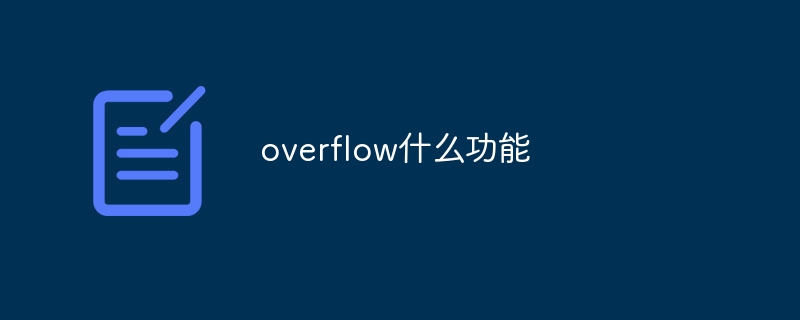
Overflow has functions such as controlling the display of overflow content, preventing overflow content from affecting the layout, achieving scrolling effects, implementing hiding effects, and handling text overflow. Detailed introduction: 1. Control the display of overflow content. By setting the overflow attribute, you can control whether the overflow content is displayed outside the element, hidden, displayed with scroll bars, or cropped. This can effectively control the layout and visibility of elements on the page. Different The value can be selected according to the needs of the appropriate overflow content display method; 2. Prevent overflow content from affecting the layout, when the content exceeds the size of the element, etc.

The operating system for this tutorial: Windows 10 system, DELL G3 computer.
In CSS, the overflow attribute is used to control how overflow content of an element is handled. When the content of an element exceeds its specified size, the overflow attribute determines how to handle the overflow content. It has the following functions:
1. Control the display of overflow content: By setting the overflow attribute, you can control whether the overflow content is displayed outside the element, hidden, displayed with scroll bars, or cropped. This effectively controls the layout and visibility of elements on the page. Different values allow you to choose the appropriate overflow content display method according to your needs.
2. Prevent overflow content from affecting the layout: When the content exceeds the size of the element, if it is not processed, the page layout may be disordered. By setting the overflow attribute to hidden or scroll, you can prevent overflowing content from affecting the layout of other elements. The hidden value hides overflowing content, while the scroll value displays scroll bars so users can scroll through the content.
3. Implement scrolling effect: By setting the overflow attribute to scroll, the scroll bar can be displayed when the content overflows, allowing users to scroll to view the content. This is useful when the container element contains a lot of text or images. Users can use scroll bars to browse overflowing content without affecting the layout of other elements.
4. Achieve hiding effect: By setting the overflow attribute to hidden, you can hide the overflow content in the element so that it is not displayed outside the element. This is useful when you need to hide overflow content or implement some special effects. Overflowing content will not be displayed, keeping the page clean and beautiful.
5. Handle text overflow: When the text content exceeds the size of the container, you can use the overflow attribute to handle the overflow of the text. Set the overflow attribute to hidden to hide the overflow text; set to scroll to display the scroll bar to allow users to scroll to view the overflow text; set to ellipsis to use ellipsis (...) to replace the overflow text.
It should be noted that the overflow attribute only works on elements with specified sizes. For elements without specified dimensions, such as inline elements or block-level elements with no set width and height, the overflow attribute has no effect.
In actual development, the overflow attribute is often used to handle overflow content in container elements, especially when dealing with text, images, or when the container contains a large amount of content. Reasonable use of the overflow attribute can avoid page layout confusion and improve user experience.
In addition, the overflow attribute can also be used in combination with other attributes, such as overflow-x and overflow-y to control the horizontal and vertical overflow of elements respectively. You can also control the way text wraps by setting the overflow-wrap or word-wrap attributes.
To summarize, the overflow attribute in CSS has functions such as controlling the display of overflow content, preventing overflow content from affecting the layout, achieving scrolling effects, implementing hiding effects, and handling text overflow. By rationally using the overflow attribute, you can handle element overflow and improve the usability and user experience of the page.
The above is the detailed content of What is the function of overflow?. For more information, please follow other related articles on the PHP Chinese website!




